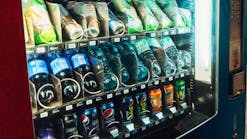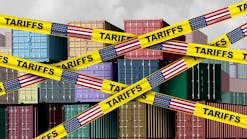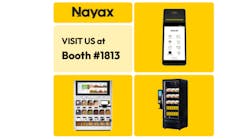Many operators in convenience services have invested in technology that has enabled the industry to deliver a better experience to clients and customers. As 2019 draws to a close, outside competitors continue to move into areas traditionally served by vending, micro markets and office coffee service (OCS). In addition to the increased availability of food and beverage delivery and pickup services, we’re seeing expanded offerings from convenience stores, drug stores and specialty grocers. Everybody is trying to win the race of giving consumers exactly what they want, when they want it.
While these competitors certainly pose a threat to business owners in convenience services, they also present an opportunity as operators have the unique advantage of already being on-site at the workplace.
“We spend more time at work than home or play, so the ability to deliver convenience across new categories is a great way to differentiate, capture new dollars and reduce the demand on traditional product margin.” explained Josh Rosenberg, CEO of PLNTSOP, a wellness company focused on developing, marketing and distributing CBD-infused products.
As the convenience services industry continues to evolve, successful operators will need to adopt new strategies and new product offerings to encourage loyalty and customer retention in the long run. We asked the Automatic Merchandiser editorial advisory board and other industry experts how operators can stay competitive in 2020.
Technology upgrades remain essential
When it comes to implementing technology, you’re never truly finished. Fortunately, once you have all your machines running on a connected network, it’s easier to incorporate the next innovative solution to increase efficiency, grow customer engagement and, ultimately, boost revenue.
“Technology continues to rapidly change the landscape of our industry,” said C.J. Recher, vice president of marketing at Five Star Food Service. “[This] technology [is] focused on making commerce easier and more convenient — giving customers what they want, when and how they want it, at a fair price.”
“Growing machine connectivity will remain an important strategy to enhance efficiency and payment options,” added Chuck Reed, vice president and general manager, vending, Crane Payment Innovations (CPI).
Paul Bardy, director of guest experience and insight analytics at Continental, said they continually work on improving and increasing customer engagement through technology — primarily mobile and tablet-based platforms — to lift sales. Relying upon scannable QR codes and real-time customer feedback via tablets, analysts can quickly examine data so the purchasing and customer service teams can expeditiously order, restock and merchandise the items customers crave. In 2020, data analysts at Continental will be using a new business intelligence platform to help the company’s teams make informed real-time decisions, plan for culinary innovations and procure top-trending packaged products. By using this platform, the company anticipates faster report-out and response to stales, bestsellers and more, which translates to better managing its locations.
“In the field, guest experience teams will engage customers and educate them about the flexibility of a digital retail experience that utilizes the company’s mobile app and [the] variety of payment options available, including all credit-debit cards and contactless payment like Google Wallet, Apple Pay and more,” said Brent Basch, Continental’s vice president of market operations. “The company is increasingly focused on kiosk promotions [such as] enter-to-win programs based on guests’ purchasing top-selling products.”
Rosenberg said that he believes many of these technologies will decrease in cost, making them available to a wider variety of businesses, particularly smaller operations.
“Equipment technology will continue to come down in cost, bring wider adoption and drive down operating expenses,” he said. “Technology will continue to enable topline sales growth through leveraging AI, merchandising data, and equipment to improve space to sales, right product/right price and velocity, all driving efficiency and consumer retention.”
Nowadays, operators can analyze data from their accounts and quickly implement changes to avoid spoilage or loss, which is essential if they offer freshly prepared foods in their vending machines and micro markets. Operators can effectively manage everything from decreasing or eliminating weak-selling items to consolidating delivery routes.
“As an operator we will continue to look at our account profitability and work diligently to shrink the tail on underperforming assets to be redeployed, repositioned or change in terms to maintain our desired threshold on performance,” Rosenberg added. “Today we have a coffee, vending, and a market route all going to the same business location. These will be consolidated for efficiency and scale to deliver all from one truck.”
Using data to create customized experiences
Consumers want to feel like they’re getting an elevated, customized experience every time they shop. Operators who have invested in implementing technology to better manage their businesses are likely to have the necessary data to deliver this customized experience to end users.
“If you think about the trajectory of vending, we went from mass distribution to what we could call ‘mass customization,’” said Maeve McKenna Duska, chief marketing officer at USA Technologies, Inc. “We’ve been able to get more specific in the products and services that we provide to customers. What’s driving this is data; our operators have lots of data now. But it’s also the consumer — they’re requiring it. Consumers want to feel like their experience is customized and that the brands being offered are brands that they see as valuable. They’re not willing to compromise just for convenience’s sake, which is something that I think is a new trend.”
Through data collection and analysis, Duska said that operators can provide hyper-customization to consumers by pinpointing the individual customer profiles in each of their accounts. This can be as simple as targeting separate products for different areas of a business, such as white-collar office and blue-collar manufacturing, or as sophisticated as launching a loyalty program that tracks what a customer buys and offers promotions based on those purchases.
“Now, rather than just following intuition, we have empirical data that supports the different product mixes of these different accounts,” Duska continued. “I do think that’s something we’ve all been dabbling in, and that will start to pick up momentum in 2020.”
According to Bardy, operators should use data gleaned from what customers purchase to deliver a best-in-class experience, ultimately boosting sales.
“QR code technology gives us a wealth of data that sharpens our focus on the latest culinary preferences and consumer buying habits,” Bardy said. “It also helps validate what new products and fresh food items we’re testing.”
Expect employer-paid services to grow
Many operators have added pantry service to their OCS routes based on client demand to offer premium paid amenities to their employees. This trend is unlikely to slow down as long as unemployment is low and the economy is strong.
“Employer paid services — pantry, OCS — continue to grow with a strong contribution of money per employee in order for employers to sustain culture, retention and recruitment efforts,” Rosenberg said.
Jim Carbone, vice president of strategic development at Tradecraft Outfitters, a division of Canteen, said that competitive employers are providing — and paying for — pantry service and elevated beverage options such as looseleaf teas, craft coffee and draft beverages.
“Draft beverages — cold brew coffee, kombucha and kegerators in offices — are very popular with millennials, and that is driving one of the most profitable parts of the convenience services business, which is pantry programs, or free snacks and beverages.” Carbone said. “Bringing craft coffee into these offices helps not only attract talent, but also retain talent.”
Carbone said that he’s seeing an increasing number of employers going the extra mile in premium services by offering in-house baristas in the workplace.
“Who would have ever thought we’d see baristas on staff making incredible quality coffee drinks for employees for free? I put programs like that in place, where there are literally baristas on staff from 7 a.m. to 5 p.m., serving an espresso or latte or cappuccino, keeping employees in place instead of going down the street to Starbucks,” Carbone said. “There’s a lot of money in it. Everybody’s looking for something better and they’re willing to spend the money.”
Steve LaPorte, president, refreshment services group at Continental, said that his company plans to partner with clients to identify the best employee benefits programs highlighted by pantry services and OCS.
“It’s something we’re trying to capitalize on this year,” LaPorte said.
New revenue streams abound
Operators who have integrated VMS software are now looking at their network of connected machines and wondering how they can drive more value to their business.
Recher said that in 2020, Five Star plans to leverage much of the technology it’s invested in to maximize its potential for the company.
“Specifically in vending, we are deploying 4,000 additional USAT ePort Interactive card readers with digital screens to replace traditional card readers that will be redeployed to lower-volume, cash-only machines,” Recher explained, noting that this will allow the company to enable machines with cashless payment technology and leverage digital advertisements and promotions to drive incremental sales.
Duska said that she believes 2020 will mark a year of interesting incremental growth opportunities for operators.
“In addition to ads offered by supplier partners, we have operators who are negotiating their own advertising deals directly with CPG companies that they have relationships with, and even local businesses,” Duska explained. “Getting regional and local advertising from a non-competing business down the road? There’s ad dollars there and there’s value there. People are already getting creative — they’re already rolling these advertisements out and they’re getting incremental revenue from it.
"And then you have the positive impact of running ads on the sales of products in the machine,” she continued. “We’re showing that there’s definitely an incremental lift in products that you advertise. So even if you don’t have an advertising deal, an operator can advertise [a product offered in vending or micro markets] and see a lift in sales."
Duska said that enterprising operators should also acknowledge the tremendous opportunity in the fact that today’s consumers are conditioned to serve themselves beyond food and beverage.
“Operators can start looking outside of their traditional food, snack and beverage business model to other non-traditional vending,” she said. “Companies have diversified with micro markets, pantry services and OCS, but they’re still very focused within food, snack and beverage. I think there’s an opportunity for these companies to take a look at things like non-traditional vending — electronics, beauty and apparel.”
Rosenberg agreed that operators should consider revenue streams beyond food and beverage, especially as new players enter the convenience services space through existing platforms to expand their retail presence.
“Innovation in product offering is the most critical means for an operator to stay healthy,” Rosenberg said. “This means diversity beyond just snack, beverage, food and coffee. Operators who diversify through new product categories — electronics, cosmetics, CBD — will find new lines of revenue.”
“Convenience stores are creeping into our space with retail offerings,” Sandy Thornton, co-owner and key accounts manager at VendEdge, added. “We must adapt and become retailers and become good at it.”
For operators who are concerned about competition from delivery services, fast-casual restaurants or specialty grocers, they can encourage customer loyalty by providing superior customer service.
“Local high-end grocers, popin restaurants, DoorDash, Uber Eats and other delivery services like Snack Nation are on our radar from a competitive standpoint,” said LaPorte. “Our answer to all to new competition inside our industry is making sure we’re engaged with the customer the right way as often as possible, creating long-term personal relationships."
Better-for-you expands in 2020
Consumers are likely to continue to demand better-for-you offerings in 2020, and those with restricted diets will turn elsewhere if they can’t find what they want in vending or micro markets.
“Eating habits are continuing to change in the marketplace,” said Thornton. “Consumers are shifting to healthier choices and away from sugar snacks and beverages. While these categories remain the largest share of business, a shift is occurring and will continue. NAMA’s public health initiative will likely speed up the process of offering better-for-you options. [In 2020] we will be offering more better-for-you items and implementing NAMA’s public health initiative.”
As Thornton pointed out, embracing NAMA’s public health commitment to increase the percentage of better-for-you offerings to 33 percent in the nation’s vending machines (announced by the organization in October 2019) can help remove the misperception that vending machines only offer “junk” food.
“NAMA’s new partnership with organizations focused on increasing healthier food options should be an inflection point for our industry in removing the inaccurate claims that vending is causing obesity,” Reed added. “With the industry now on our front foot on this issue, we can prove that we are part of the solution.”
Of course, none of this would make sense if it didn’t help an operator’s bottom line, and Duska noted that NAMA’s public health initiative wouldn’t have been possible if NAMA didn’t have the data from operators to back it up.
“NAMA’s healthier initiative in partnership with the FDA is all databased,” she said. “That would not even have been possible 10 years ago. Now they’re going to government and association stakeholders and saying, ‘Here’s something we want to do — we want to provide healthier choices for people. Let’s take a look at what we’re currently offering and make some meaningful changes and see how that impacts consumer behavior.’ We have data now and it opens the door to a world of new initiatives and revenue streams.”
Looking further
Another trend operators have been curious about is CBD. While some may question whether CBD-infused beverages and food should be offered in the workplace, many operators are looking into it as consumers grow more accepting of CBD products.
“We are actively researching CBD products and where they would fit in our offerings,” Thornton said.
While artificial intelligence (AI) and machine learning may have seemed like far-off concepts for this industry a few years ago, they’re starting to be put into practice to help operators better identify trends and respond to changes in their accounts. Duska said that AI is still in the investigative phase, but operators are interested in finding practical applications for this technology.
“There’s a lot of interest but not a lot of commercialization of these AI solutions,” she said. “I think that will happen in 2020, particularly toward the end of the year as we see results of extended field trials and those results motivate others to move forward. I think those results, combined with the consumers’ drive and desire for hyper-customization, are going to start pushing people towards a machine learning business model. Being able to deliver a hyper-customized solution can become very manual and time-consuming to deliver effectively – it’s too hard to scale without automation. This is what AI will offer.”
In conclusion
While 2020 is clearly ripe with opportunity for operators, there are many threats to the convenience services industry beyond delivery services, convenience stores, restaurants and Amazon Go. Sometimes the biggest threats are closest to home.
“The greatest threat to convenience services is our race to the bottom,” Rosenberg said. “As operators have experienced tremendous growth, the industry has started to compete against ourselves.”
Rosenberg added that the convenience services industry is well-positioned due to the strong workforce, proximity retail and technology advancements enabling a more diverse product offering. But the cost of capital, labor and the influx of the uberization of modern retail will challenge industry profitability.
“The risk of a softening economy could add to the cost pressure operators face as they try to improve bottom-line performance,” he said.
If the economy experiences a downturn in 2020, operators who are quick to react to a rapidly changing market will have a better chance of weathering this storm.
“One of the greatest threats to our industry is — and has been for the past five years — the rate at which we adapt to the changes in the business environment,” Recher said. “If we as individual operators and as a collective industry don’t adapt quickly enough, we risk losing potential incremental growth opportunities as well as allowing external competition to creep into the space.”

Abby White
Abby White is a former chief editor for Automatic Merchandiser and VendingMarketWatch.com.






